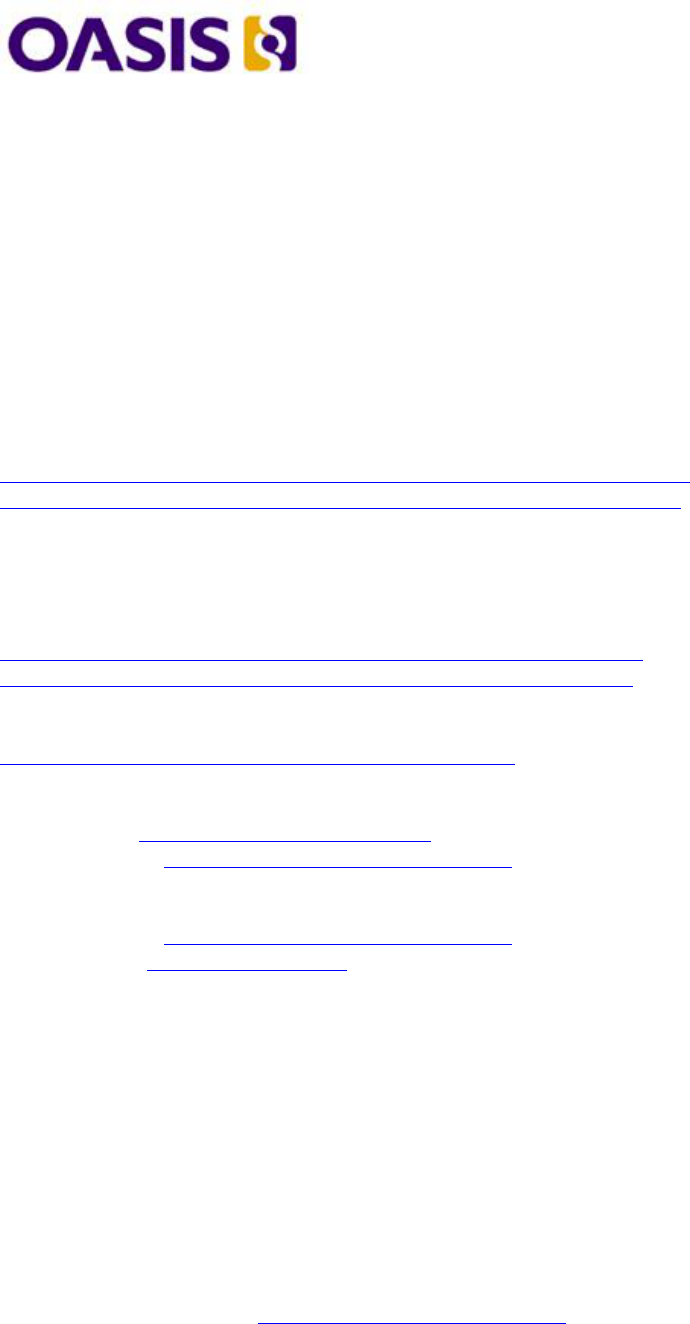
XLIFF 1.2 Representation Guide for Java
Resource Bundles
Committee Draft 02
30 April 2007
Specification URIs:
This Version:
http://docs.oasis-open.org/xliff/v1.2/xliff-profile-java/xliff-profile-java-v1.2-cd02.html
http://docs.oasis-open.org/xliff/v1.2/xliff-profile-java/xliff-profile-java-v1.2-cd02.pdf
Previous Version:
Not applicable yet
Latest Version:
http://docs.oasis-open.org/xliff/v1.2/xliff-profile-java/xliff-profile-java-v1.2.html
http://docs.oasis-open.org/xliff/v1.2/xliff-profile-java/xliff-profile-java-v1.2.pdf
Technical Committee:
OASIS XML Localisation Interchange File Format (XLIFF) TC
Chair(s):
Bryan Schnabel
Tony Jewtushenko [email protected]
Editor(s):
Tony Jewtushenko
Rodolfo M. Raya [email protected]
Abstract:
This document describes how Java Resource Bundles, should be coded when extracted to an XLIFF document.
Status:
This document was last revised or approved by the XLIFF TC on the above date. The level of approval is also listed
above. Check the current location noted above for possible later revisions of this document. This document is updated
periodically on no particular schedule.
Technical Committee members should send comments on this specification to the Technical Committee’s email list.
Others should send comments to the Technical Committee by using the “Send A Comment” button on the Technical
Committee’s web page at
www.oasis-open.org/committees/xliff

For information on whether any patents have been disclosed that may be essential to implementing this specification,
and any offers of patent licensing terms, please refer to the Intellectual Property Rights section of the Technical
Committee web page (
http://www.oasis-open.org/committees/xliff/ipr.php).
The non-normative errata page for this specification is located at
www.oasis-open.org/committees/xliff/documents/xliff-
core-1.2-errata.htm
Notices
Copyright © OASIS® 1993 - 2007. All Rights Reserved. OASIS trademark, IPR and other policies apply.
All capitalized terms in the following text have the meanings assigned to them in the OASIS Intellectual Property Rights
Policy (the "OASIS IPR Policy"). The full Policy may be found at the OASIS website.
This document and translations of it may be copied and furnished to others, and derivative works that comment on or
otherwise explain it or assist in its implementation may be prepared, copied, published, and distributed, in whole or in part,
without restriction of any kind, provided that the above copyright notice and this section are included on all such copies and
derivative works. However, this document itself may not be modified in any way, including by removing the copyright notice or
references to OASIS, except as needed for the purpose of developing any document or deliverable produced by an OASIS
Technical Committee (in which case the rules applicable to copyrights, as set forth in the OASIS IPR Policy, must be
followed) or as required to translate it into languages other than English.
The limited permissions granted above are perpetual and will not be revoked by OASIS or its successors or assigns.
This document and the information contained herein is provided on an "AS IS" basis and OASIS DISCLAIMS ALL
WARRANTIES, EXPRESS OR IMPLIED, INCLUDING BUT NOT LIMITED TO ANY WARRANTY THAT THE USE OF THE
INFORMATION HEREIN WILL NOT INFRINGE ANY OWNERSHIP RIGHTS OR ANY IMPLIED WARRANTIES OF
MERCHANTABILITY OR FITNESS FOR A PARTICULAR PURPOSE.
OASIS requests that any OASIS Party or any other party that believes it has patent claims that would necessarily be infringed
by implementations of this OASIS Committee Specification or OASIS Standard, to notify OASIS TC Administrator and provide
an indication of its willingness to grant patent licenses to such patent claims in a manner consistent with the IPR Mode of the
OASIS Technical Committee that produced this specification.
OASIS invites any party to contact the OASIS TC Administrator if it is aware of a claim of ownership of any patent claims that
would necessarily be infringed by implementations of this specification by a patent holder that is not willing to provide a
license to such patent claims in a manner consistent with the IPR Mode of the OASIS Technical Committee that produced
this specification. OASIS may include such claims on its website, but disclaims any obligation to do so.
OASIS takes no position regarding the validity or scope of any intellectual property or other rights that might be claimed to
pertain to the implementation or use of the technology described in this document or the extent to which any license under
such rights might or might not be available; neither does it represent that it has made any effort to identify any such rights.
Information on OASIS' procedures with respect to rights in any document or deliverable produced by an OASIS Technical
Committee can be found on the OASIS website. Copies of claims of rights made available for publication and any assurances
of licenses to be made available, or the result of an attempt made to obtain a general license or permission for the use of
such proprietary rights by implementers or users of this OASIS Committee Specification or OASIS Standard, can be obtained
from the OASIS TC Administrator. OASIS makes no representation that any information or list of intellectual property rights
will at any time be complete, or that any claims in such list are, in fact, Essential Claims.
The name "OASIS" is a trademark of
OASIS, the owner and developer of this specification, and should be used only to refer
to the organization and its official outputs. OASIS welcomes reference to, and implementation and use of, specifications,
while reserving the right to enforce its marks against misleading uses. Please see
http://www.oasis-open.org/who/trademark.
php for above guidance.

Table of Contents
1. Introduction
1.1. Purpose
1.2. Transitional and Strict
2. General Considerations
2.1. Java Resource Types
2.2. ListResourceBundle
2.3. PropertyResourceBundle
2.4. Extraction Techniques
2.5. Order Of Extraction
2.6. Key Identifier
2.7. Preserving Message Replaceables in Value
2.8. Comments
2.9. Sample Properties File represented as XLIFF
2.10 Sample List Resources Java Class represented as XLIFF
A. Contributions
B. Examples
C. References
1. Introduction
As different tools may provide different filters to extract the content of Java Resource Bundles, it is important for
interoperability that they represent the extracted data in identical manner in the XLIFF document.
1.1. Purpose
The intent of this document is to provide a set of guidelines to represent data contained in Java Resource Bundles as XLIFF
content. It offers a collection of recommended mapping of Java Resource Bundles that developers of XLIFF filters can
implement, and users of XLIFF utilities can rely on to insure a better interoperability between tools.
1.2 Transitional and Strict
XLIFF is specified in two "flavors". Indicate which of these variants you are using by selecting the appropriate schema. The
schema may be specified in the XLIFF document itself or in an OASIS catalog. The namespace is the same for both variants.
Thus, if you want to validate the document, the tool used knows which variant you are using. Each variant has its own
schema that defines which elements and attributes are allowed in certain circumstances.
As newer versions of XLIFF are approved, sometimes changes are made that render some elements, attributes or constructs
in older versions obsolete. Obsolete items are deprecated and should not be used even though they are allowed. The XLIFF
specification details which items are deprecated and what new constructs to use.
● Transitional - Applications that produce older versions of XLIFF may still use deprecated items. Use this variant to
validate XLIFF documents that you read. Deprecated elements and attributes are allowed.
xsi:schemaLocation='urn:oasis:names:tc:xliff:document:1.2 xliff-core-1.2-transitional.
xsd'
● Strict - All deprecated elements and attributes are not allowed. Obsolete items from previous versions of XLIFF are
deprecated and should not be used when writing new XLIFF documents. Use this to validate XLIFF documents that
you create.
xsi:schemaLocation='urn:oasis:names:tc:xliff:document:1.2 xliff-core-1.2-strict.xsd'

2. General Considerations
This section discusses the general considerations to take in account when extracting Java Resource Bundle data.
2.1. Java Resource Types
Java's architecture supports the localization of application resources via the java.util.ResourceBundle abstract class.
This class has two subclasses: PropertyResourceBundle and ListResourceBundle. A ResourceBundle contains
key/value pairs, where each key uniquely identifies locale-specific objects in the bundle. Non-string resources, binary objects,
must be stored in ListResourceBundle, since the PropertyResourceBundle can only contain String objects. String
values can contain MessageFormat replaceables, which are delimited within {}.
2.2. ListResourceBundle
A < class="element"code>ListResourceBundle is a list of resources stored in a .class file. Compiled resources are stored in
binary format, which means < class="element"code>ListResourceBundle can contain localized resources of any data type.
Additional locales are created by copying the base .java file to a locale specific .java file identified by adding a locale suffix to
its filename. After translation has been completed, the localized .java file is compiled into a .class file.
Listing 1 shows a sample ListResourceBundle class named "DiskResources.java" and a version for "es" locale.
import java.awt.Rectangle;
import java.util.ListResourceBundle;
public class DiskResources extends ListResourceBundle {
public Object[][] getContents() {
return contents;
}
static final Object[][] contents = {
{"key1", "Cabinet {0} contains {1} folders."},
{"key2", "Folder {0} contains " +
"{1,choice,0#no files|1#one file|1<{1,number,integer} files}."},
{"key3", "Folder \'{0}\' is empty."},
{"key4", "File \"My Stuff\" deleted."},
{"key5", "Added {0,number} files."},
{"key6", new Rectangle(10,25,100,150)},
{"key7", "No files were removed while processing " +
"current folder."}
};
}
--------------------------------------------
import java.awt.Rectangle;
import java.util.ListResourceBundle;
public class DiskResources extends ListResourceBundle {
public Object[][] getContents() {
return contents;
}
static final Object[][] contents = {
{"key1", "El gabinete {0} contiene {1} carpetas."},
{"key2", "La carpeta {0} contiene " +
"{1,choice,0#cero archivos|1#un archivo|1<{1,number,integer} archivos}."},
{"key3", "La carpeta \'{0}\' está vacía."},
{"key4", "Archivo \"Mis cosas\" eliminado."},
{"key5", "{0,number} archivos añadidos."},
{"key6", new Rectangle(10,25,100,150)},
{"key7", "Ningún archivo fue eliminado al procesar " +
"la carpeta actual."}
};
}
Listing 1 - Sample List Resource file

2.3. PropertyResourceBundle
PropertyResourceBundle is a concrete implementation of ResourceBundle class that stores translatable String
resources in plain text files via name-value pairs using "name=value" syntax.
The resources of a PropertyResourceBundle are stored in files with the extension ".properties". Properties files strings
are fetched at run-time, they are not compiled. The keys are case-sensitive and should be unique within the .properties file.
Listing 2 below is a sample PropertyResourceBundle .properties file with four localizable strings.
# Copyright information
key1=Copyright \u00A9 2006 FARO Inc.
key2=Box 12 is {0,number} inches high.
key3=Box ''{0}'' is blue.
key4=Boxes are built in three sizes: small, \
medium and large.
Listing 2 - Sample .properties file
2.4.Extraction Techniques
Resource Bundles are Java code and not XML. Therefore, XSL transformation standards cannot directly be utilized to
convert the resource bundles into XLIFF. XSLT could be used to transform the translated XLIFF back to the native Java, or to
manipulate an intermediate XML or initial XLIFF file in preparation for manual or automated Computer Aided Translation
(CAT), but software best practices favour using the same technology for both extraction and recomposition.
The class java.util.Properties provides methods for converting .properties files to XML format. Listing 3 shows the
XML version of the .properties file from Listing 2.
<?xml version="1.0" encoding="UTF-8"?>
<!DOCTYPE properties SYSTEM "http://java.sun.com/dtd/properties.dtd">
<properties>
<comment>Listing 2</comment>
<entry key="key4">Boxes are built in three sizes: small, medium and large.</entry>
<entry key="key3">Box ''{0}'' is blue.</entry>
<entry key="key2">Box 12 is {0,number} inches high.</entry>
<entry key="key1">Copyright © 2006 FARO Inc.
</entry>
</properties>
Listing 3 - Java resources in XML format
XML files generated using class Properties can be converted to XLIFF using XSL transformations or specialized XML
filters. Processing of Java resources stored in XML format is beyond the scope of this document.
2.4.1. Using Filters
It is necessary to extract the Java Resource Bundles- List and Property - to XLIFF by developing a custom filter application.
Such tools can be written using a variety of programming and scripting languages such as Perl, Python, C, C++, C#, Java,
etc..
This document makes no assumption on the type of language used to process the Java ResourceBundle input documents.
It also makes no assumptions whether or not the tool creates a Skeleton file along with the XLIFF document generated, or if it
creates one, how data are represented in the Skeleton.
The following guidelines should be adhered to:

● Each .properties file is represented in a separate <file> element in an XLIFF document
● The datatype attribute of a <file> element is set to javapropertyresourcebundle or
javalistresourcebundle, depending on the type of resource
● The <body> element contains a separate <trans-unit> element for each key-value pair
● The translate attribute of <trans-unit> element is set to no when the value string is a null string
● The value string becomes the content of the child <source> element
Characters that require a special representation in a ResourceBundle should be parsed by the XLIFF filter and represented
appropriately in the XLIFF file. The following cases should be contemplated when designing a filter:
● Single quotes, double quotes, backslashes and other special characters need to be prefixed with a '\' character in
ListResourceBundle classes. Filters should use unescaped versions of these characters in the XLIFF file.
● Properties files are written using ISO 8859-1 character set. All characters not supported by this character set are
encoded using the \uXXXX Java notation for Unicode. Filters should replace encoded characters with their
appropriate Unicode versions in the XLIFF file.
● Long strings can be concatenated using '+' operator in ListResourceBundle classes (see the last entry in Listing
1). Filters should automatically merge concatenated strings.
● A '\' character at the end of a line in a .properties file indicates that the text to translate continues in the following line
(see the last entry in
Listing 2 ). Filters should automatically merge split lines.
2.5. Order of Extraction
The flow of the extracted data in the XLIFF document should be in the same order as the flow of data in the original
ResourceBundle. The extraction order should reflect the order of the data in the source document, and the author is
responsible to group logical parts of the text together as much as possible.
2.6. Key Identifier
The identifier used for matching, leveraging, and other ID-related functions is stored in the resname attribute. The key of the
resource becomes the resname attribute value of the <trans-unit> element.
The required id attribute of the XLIFF <trans-unit> element is an identifier allowing extraction tools to merge back the
data. The value of the id attribute is serially assigned, according the retrieval order, to maintain consistency and uniqueness.
2.7. Preserving Message Replaceables in Value
Variable data is represented in Java strings using special descriptors surrounded by { and }. Those descriptors, called
"replaceables", are processed by the MessageFormat class at run-time to display variable data in the appropriate format for
the selected locale. MessageFormat replaceables should be enclosed in <ph> elements by the filter that generates the
XLIFF representation. If Skeleton files are used, a replaceable can optionally be represented with an <x/> tag instead of a
<ph> element.
Replaceables of type choice include a parameter with two or more translatable strings. The string to display is selected at
run-time according to a given condition. Replaceables of type choice should be encapsulated in <ph> elements, enclosing
translatable strings in <sub> elements. Filter designers can parse the parameter with strings and hide the logic from the
translator by using more than one <sub> element or expose the whole parameter, giving the translator the possibility to
change the selection criteria according to the grammar of the target language.
Listing 4 shows a replaceable of type choice
and its two possible representations.
key2=Folder {0} contains {1,choice,0#no files|1#one file|1<{2,number,integer}files}.
--------------------------------------------

<source>Folder <ph id="1">{0}</ph> contains <ph
id="2">{1,choice,0#<sub>no files</sub>|1#<sub>one
file</sub>|1<{2,number,integer}<sub>files</sub>}</ph>.
</source>
<source>Folder <ph id="1">{0}</ph> contains
<ph id="2">{1,choice,<sub>0#no files|1#one file|1<{2,number,integer}files</sub>}</ph>.
</source>
Listing 4 - XLIFF representation of choice-type replaceables
Best localization practices recommend using class java.text.MessageFormat to produce concatenated messages in
language-neutral way. However, it is possible to concatenate translatable strings and variables using a '+' operator. Filters
should encapsulate variables and operators using either <ph> or <x/> tags as shown in
Listing 5 .
String title = getBookTitle();
int bookNumber = 23801;
public Object[][] getContents() {
return contents;
}
static final Object[][] contents = {
{"key1", "Title: " + title + " - Number: " + bookNumber},
};
--------------------------------------------
<source>Title: <ph id="1"> + title + </ph> - Number: <ph id="2"> + bookNumber</ph>
</source>
Listing 5 - Strings and variables concatenated.
Although most of the XLIFF inline tags are represented in the TMX Standard, the <x/> tag is not. TMX is a standard to
exchange Translation Memory (TM) data created by Computer Aided Translation (CAT) and localization tools. If you plan to
store or deliver XLIFF text content using TMX, you may wish to use <ph> elements for encapsulating replaceables.
Otherwise, you will need to represent <x/> tags in some alternate way in TMX.
2.8. Comments
Lines that start with a # character are comments in .properties files. These lines do not contain translatable text. Filter
designers may optionally concatenate consecutive comment lines and include them as context information in one <note>
element in the first <trans-unit> generated after extracting the comments.
Comments in classes derived from ListResourceBundle are subject to Java coding rules. If an XLIFF filter tool finds
comments inside a run of localizable text in a class that extends ListResourceBundle, the comment should be preserved
by being treated as inline code and enclosed in a <ph> element. If Skeleton files are used, the comment can optionally be
represented with an <x/> tag instead of a <ph> element.
In ListResourceBundle resources, if an XLIFF filter finds comments following a key value pair, those comments can be
associated with the corresponding <trans-unit> element using a <note> element.
2.9 Sample Properties File represented as XLIFF:
Listing 6 below contains the XLIFF representation of the .properties file shown in Listing 2.
<?xml version="1.0" encoding="UTF-8"?>
<xliff version="1.2" xmlns="urn:oasis:names:tc:xliff:document:1.2"
xmlns:xsi="http://www.w3.org/2001/XMLSchema-instance"
xsi:schemaLocation="urn:oasis:names:tc:xliff:document:1.2

xliff-core-1.2-strict.xsd">
<file original="sample.properties" source-language="en"
datatype="javapropertyresourcebundle">
<body>
<trans-unit id="0" resname="key1">
<source xml:lang="en">Copyright © 2006 FARO Inc.
</source>
<note>Copyright information</note>
</trans-unit>
<trans-unit id="1" resname="key2">
<source xml:lang="en">Box 12 is
<ph id="1">{0,number}</ph> inches high.</source>
</trans-unit>
<trans-unit id="2" resname="key3">
<source xml:lang="en">Box ''<ph id="1">{0}</ph>'' is blue.</source>
</trans-unit>
<trans-unit id="3" resname="key4">
<source xml:lang="en">Boxes are built in three sizes: small, medium and
large.</source>
</trans-unit>
</body>
</file>
</xliff>
Listing 6 - XLIFF representation of a .properties file
2.9 Sample List Resources Java Class represented as XLIFF:
Listing 7 shows the XLIFF document with localizable data extracted from the class "DiskResources.java" included in Listing 1.
<?xml version="1.0" encoding="UTF-8"?>
<xliff version="1.2" xmlns="urn:oasis:names:tc:xliff:document:1.2"
xmlns:xsi="http://www.w3.org/2001/XMLSchema-instance"
xsi:schemaLocation="urn:oasis:names:tc:xliff:document:1.2
xliff-core-1.2-strict.xsd">
<file original="DiskResources.java" source-language="en"
datatype="javalistresourcebundle">
<body>
<trans-unit id="0" resname="key1">
<source>Cabinet
<ph id="1">{0}</ph> contains
<ph id="2">{1}</ph> folders.</source>
</trans-unit>
<trans-unit id="1" resname="key2">
<source>Folder
<ph id="1">{0}</ph> contains
<ph id="2">{1,choice,<sub>0#no files|1#one
file|1<{0,number,integer} files}</sub>
</ph>.</source>
</trans-unit>
<trans-unit id="2" resname="key3">
<source>Folder '<ph id="1">{0}</ph>' is empty.</source>
</trans-unit>
<trans-unit id="3" resname="key4">
<source>File "My Stuff" deleted.</source>
</trans-unit>
<trans-unit id="4" resname="key5">
<source>Added
<ph id="1">{0,number}</ph> files.</source>
</trans-unit>
<trans-unit id="5" resname="key7">
<source>No files were removed while processing current folder.</source>
</trans-unit>
</body>
</file>
</xliff>

Listing 7 - XLIFF representation of a List Resource Bundle
A. Contributions
The following people have contributed to this document:
● Eiju Akahane, IBM
● Doug Domeny
● Tony Jewtushenko
● Milan Karásek
● Christian Lieske, SAP AG
● Matthew Lovatt, Oracle Corporation
● Magnus Martikainen, SDL International
● David Pooley, SDL International
● Rodolfo M. Raya, Heartsome Holdings Pte Ltd
● John Reid, Novell
● Peter Reynolds, Idiom Technologies, Inc.
● Florian Sachse
● Bryan Schnabel
● David Walters, IBM
● Shigemichi Yazawa
● Andrzej Zydron
B. Examples
The following sample files are available for download:
Listing 1:
DiskResource.java
Listing 2;
sample.properties
Listing 3:
sample.properties.xml
Listing 6:
sample.properties.xlf
Listing 7:
DiskResource.java
C. References
[ISO]
International Organization for Standardization Web site.
[Java]
Core Java Internationalization Web Site
Documentation of ResourceBundle Class
[OASIS]
Organization for the Advancement of Structured Information Standards Web site.
[RFC 3066]
RFC 3066 Tags for the Identification of Languages . IETF (Internet Engineering Task Force), Jan 2001.

